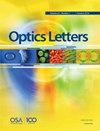采用平衡检测的超灵敏聚焦激光微分干涉仪。
IF 3.3
2区 物理与天体物理
Q2 OPTICS
引用次数: 0
摘要
平衡检测被证明是一种简单的方法来实现射击噪声限制测量与聚焦激光微分干涉仪(FLDI)。信号光束的两个偏振分量分别被检测,两个信号的差分放大消除了共模激光强度噪声。超声源用于提供参考信号,以比较传统FLDI和改进仪器的测量结果。平衡检测被证明可以将信噪比提高30 dB,并证明可以实现短噪声限制的测量。本文章由计算机程序翻译,如有差异,请以英文原文为准。
Ultra-sensitive focused laser differential interferometer using balanced detection.
Balanced detection is demonstrated to be a simple method for achieving shot-noise-limited measurements with a focused laser differential interferometer (FLDI). Both polarization components of the signal beam are separately detected, and differential amplification of the two signals cancels common-mode laser-intensity noise. An ultrasonic source is used to provide a reference signal to compare measurements made by a conventional FLDI with those from the modified instrument. Balanced detection is shown to improve the signal-to-noise ratio by 30 dB and demonstrated to achieve shot-noise-limited measurements.
求助全文
通过发布文献求助,成功后即可免费获取论文全文。
去求助
来源期刊

Optics letters
物理-光学
CiteScore
6.60
自引率
8.30%
发文量
2275
审稿时长
1.7 months
期刊介绍:
The Optical Society (OSA) publishes high-quality, peer-reviewed articles in its portfolio of journals, which serve the full breadth of the optics and photonics community.
Optics Letters offers rapid dissemination of new results in all areas of optics with short, original, peer-reviewed communications. Optics Letters covers the latest research in optical science, including optical measurements, optical components and devices, atmospheric optics, biomedical optics, Fourier optics, integrated optics, optical processing, optoelectronics, lasers, nonlinear optics, optical storage and holography, optical coherence, polarization, quantum electronics, ultrafast optical phenomena, photonic crystals, and fiber optics. Criteria used in determining acceptability of contributions include newsworthiness to a substantial part of the optics community and the effect of rapid publication on the research of others. This journal, published twice each month, is where readers look for the latest discoveries in optics.
 求助内容:
求助内容: 应助结果提醒方式:
应助结果提醒方式:


